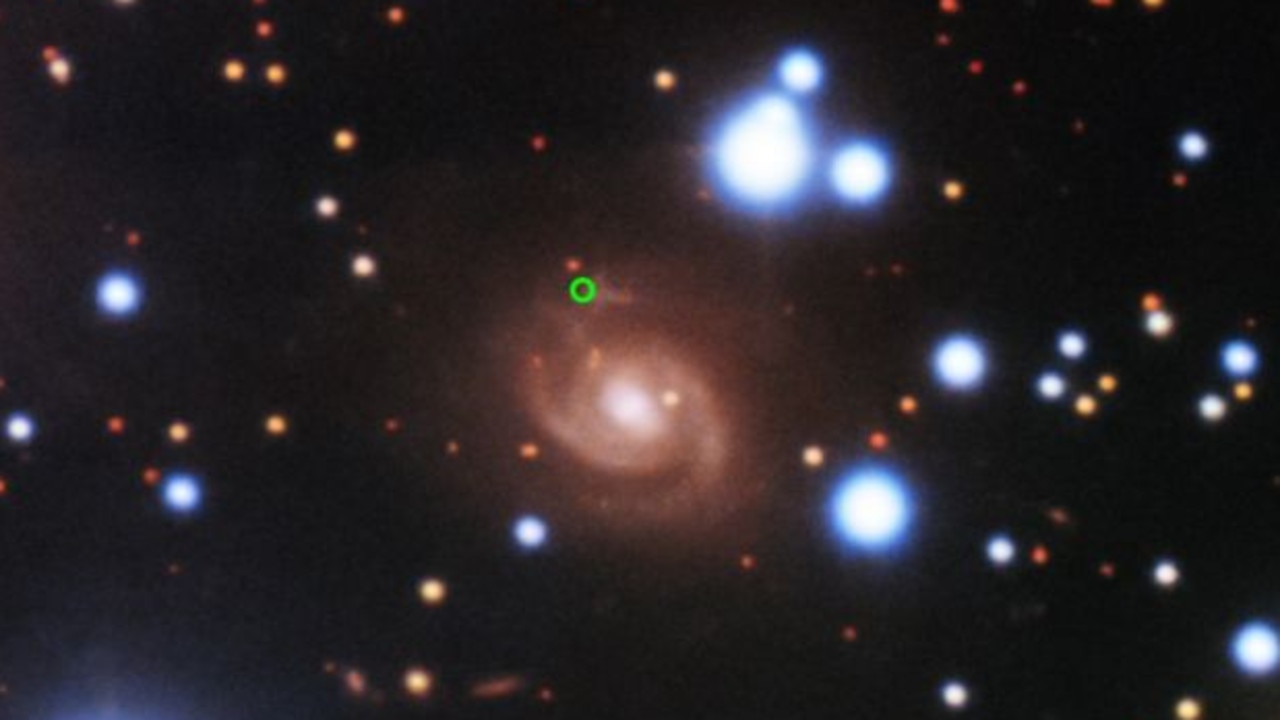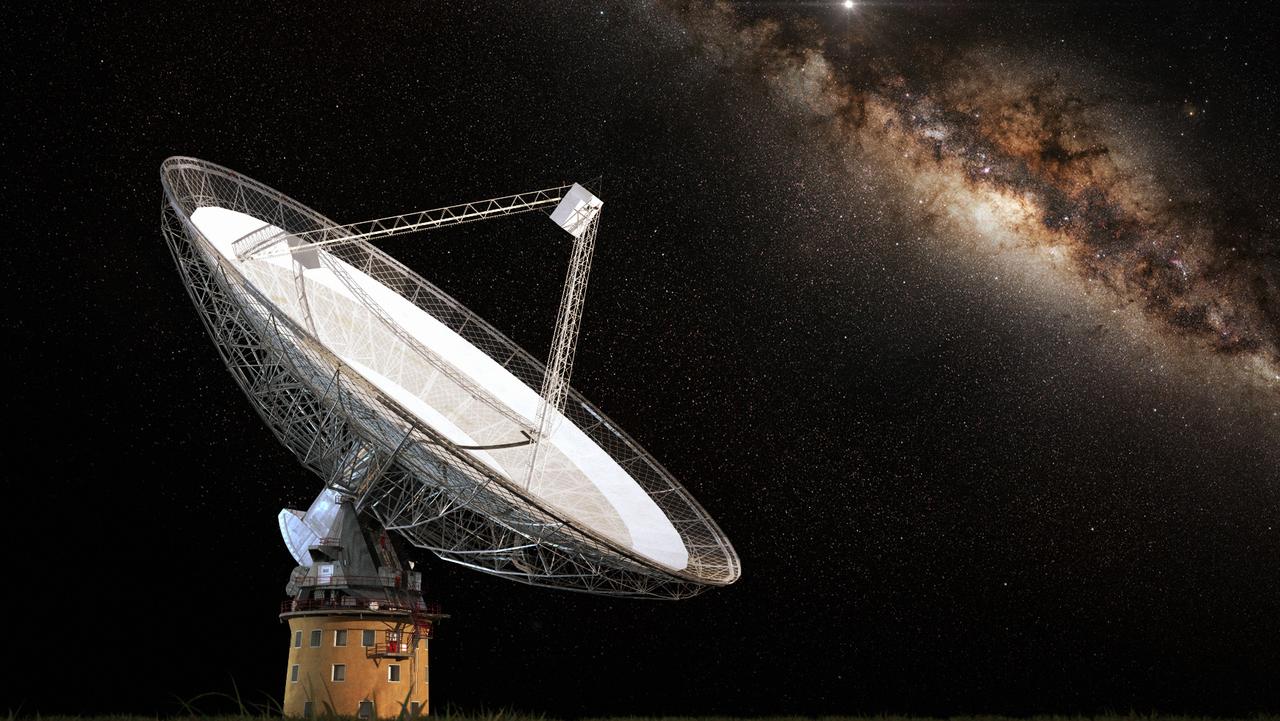Mystery behind galaxy’s repeating radio bursts
A series of radio chirps is being blasted across the gulf of space every 16 days. They’re powerful enough to light up the sky. But nobody knows why.
A nearby galaxy is talking to us. A series of radio chirps, just milliseconds long, is being blasted across the gulf of space every 16 days. They’re powerful enough to light up the sky. But nobody knows why.
The phenomenon of Fast Radio Bursts (FRBs) was, first detected by Australian radio astronomers at the Parkes Telescope in 2007. It’s a flare of electromagnetic energy, with the intensity of tens of millions of suns.
More than 100 such bewildering bursts have been detected since.
At first, they were thought to be random. But, in recent years, a fraction have been seen to repeat themselves.
Now, several newly discovered radio bursts are throwing a spanner in the works of our understanding of how they work.
RELATED: Mysterious fast radio bursts continue to baffle astronomers
The Canadian Hydrogen Intensity Mapping Experiment Fast Radio Burst Project (CHIME/FRB) has discovered a repeater called FRB 180916 is particularly repetitive.
Watching between September 2018 and October 2019, it saw a cluster of bursts over four days – followed by 12 days of silence. This 16.35-day cycle was then seen to repeat.
The study comes hard on the heels of an Australian research paper which also caught a repeating source of FRBs: “We are now starting to unravel the enigmatic astrophysical phenomenon of fast radio bursts,” the Australian-led research team writes in a study published in The Astrophysical Journal Letters.
COUNTING 16.35
The Canadian study was watching a galaxy designated SDSS J015800.28+654253.0.
It’s a spiral galaxy sitting some half a billion light-years from Earth.
It had been suspected as the source of the closest FRB so far detected.
“We conclude that this is the first detected periodicity of any kind in an FRB source,” the team said in their arXiv study.
“The discovery of a 16.35-day periodicity in a repeating FRB source is an important clue to the nature of this object.”
Problem is, this location is entirely different from that attributed to other FRBs. It’s a typical mid-sized spiral galaxy, like the Milky Way.
One repeating FRB has been traced to a tumultuous metallic dwarf galaxy.
Three non-repeating bursts came from ancient, massive galaxies with little sign of new star formation.

The researchers speculate the source of FRB 180916. J0158+65 may be rapidly orbiting a small object, such as a black hole.
This would account for a periodic cycle – the amount of time it takes for the radio beam to return to the point where it was aimed at Earth.
Another team examining the same data speculated the signal could be being blasted out by a neutron star.
If this was in a binary system with another star, the second star’s stellar winds could produce a distorting effect.
But neither explanation is a perfect fit. Yet.
FRBs remain baffling. But the discovery of a clear rhythm presents a significant new insight.
THE ODD, ANGRY CHIRP
The Australian study was looking along the direction of a particularly powerful pulse of electromagnetic energy seen in 2017. It was spotted again – albeit some 590 times less energetic.
Dubbed FRB 171019, its exact point of origin is not known. But the general patch of sky it came from is.
Three radio telescopes around the world were called on for the survey: The Australian Square Kilometre Array Pathfinder (ASKAP) in Western Australia, the Parkes Observatory in New South Wales, and the Green Bank Telescope in the United States.
Only Green Bank saw anything, recording two faint new blips on its screen.

Then later last year, a separate experiment in Canada found a third repeat signal from FRB 171019.
Confidence is high that they came from the same location as the first, bright burst. Each of the signals shares the same pulse characteristics.
But no particular rhythm has so far been determined.
UNKNOWN ORIGINS
Astrophysicists still have no idea what is causing these fast radio bursts.
“The existence of repetitions ruled out cataclysmic progenitor scenarios for the origin of its emission,” the Australian study finds
But the odds of zeroing in on the cause have improved dramatically.
The point of origin of the rhythmic FRB 180916 has been traced to a nearby spiral galaxy.
A galaxy close enough to observe in greater detail.
“We have a new chance to perhaps detect emissions at other wavelengths – X-ray or visible light, for instance,” said McGill astrophysicist Victoria Kaspi.
The FRB It isn’t coming from the galaxy’s centre, as some expected.
Instead, the high energy pulses come from a point on an outer spiral arm observed to be a nursery of new stars.
Are they pulsars (a rapidly rotating neutron star that emits a beam of radio waves)?
Are they magnetars (neutron stars with immensely strong magnetic fields)?
Indications are there must be something additional involved.
Something has to be accumulating the tremendous amount of energy before releasing a signal billions of light-years across space and time.
And that something must be focusing the energy into narrow bands of the radio spectrum.
As yet, that could be almost anything. Or any number of things.



